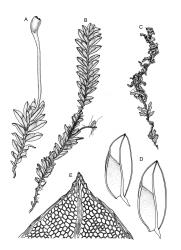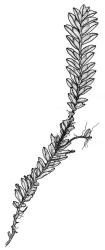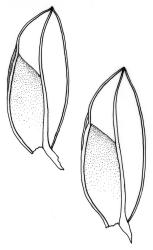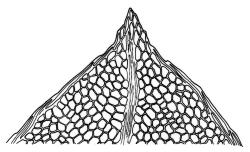Plants up to 35 mm, pale green, densely gregarious. Stems moderately branched, rhizoids at branch bases and in axils of older leaves. Leaves in 10–40(–50) pairs, not overlapping at mid stem, spreading, weakly decurved when moist, strongly and irregularly crispate when dry, oblong-ovate, 1.6–2.1 × 0.7–0.8 mm; apex acute, sometimes mucronate; laminae unistratose; vaginant laminae c. ½ leaf length, closed; dorsal lamina ending at leaf insertion or shortly decurrent on stem, tapered to its base; margins minutely serrulate near leaf apex, otherwise entire; marginal cells on apical and dorsal laminae distinct in 1–3 rows, thicker-walled, prosenchymatous, forming a narrow border failing near leaf apex and sometimes also at base of dorsal lamina, on vaginant laminae forming a wider border (–5) cell rows; cells of apical and dorsal laminae irregularly hexagonal, many oblate, smooth, weakly bulging, thin-walled, (9.0–)12.0–14.0(–19.0) × (9.0–)10.5–12.0(–18.0) µm. Costa percurrent, modified bryoides-type in cross-section (all cells thin-walled).
Synoicous? Perichaetia terminal; perichaetial leaves little differentiated. Perigonia not seen. Setae light brown, 5–7 mm; capsules inclined, asymmetric, 0.8–1.4 mm; exothecial cells in c. 90 columns; operculum not seen. Peristome bryoides-type; teeth with long-columnar papillae on the adaxial trabeculae below the bifurcation, 58–71 µm wide at the base. Mature calyptra not seen. Spores 18–25 µm.
Bruggeman-Nannenga 1979, fig. 5, a–g; Catcheside 1980, fig. 13 (as F. crassipes); Stone & Catcheside 2012. Streimann’s (2002, fig. 34) illustration depicts F. leptocladus.
As a robust species of Fissidens with bordered leaves, in aquatic and intermittently aquatic habitats, confusion is most likely with F. rigidulus or F. leptocladus. Fissidens dietrichiae differs from both these species by having flat, thin-walled, larger, and more pellucid lamina cells, and larger spores.
K.
Australasian and western Oceanic. Mainland Australia*. Fissidens dietrichiae is recorded in all the central and eastern states of Australia, but not from Tasmania (Streimann & Klazenga 2002; Stone & Catcheside 2012). Also reported from New Caledonia and Lord Howe I. (Bruggeman-Nannenga 1979), and from the Solomon Is (Bruggeman-Nannenga 2009). The sole record for Norfolk I. by Streimann (2002) is not accepted here; the voucher (HS 34805!) is referable to F. leptocladus.
In N.Z. this species has been recorded from the Kermadec Is only. It is known there from recent collections (P.J. de Lange K179 & D. Havell, CHR 617493; P.J. de Lange K600, AK 348720) in ravines on Raoul I., in association with Cyclodictyon blumeanum and Fissidens asplenioides. The habitat is recorded as being at "the margins of rock-pools in an ephemeral stream bed, and at the flood-line in a deep water-scoured ravine, on substrates of silt and of weathered breccia" at an elevation of c. 150 m. In Australia the species is similarly "usually aquatic" (Catcheside 1980) or "semiaquatic on rocks or terrestrial in damp places" (Stone & Catcheside 2012).
Fissidens dietrichiae is classified as "Data Deficient" in the N.Z. Threat Classification System (Glenny et al. 2011).
Known localities in Australia extend to at least as far south as Melbourne, where it was collected by J.H. Willis from wet, muddy rocks on the banks of the Yarra River (Willis 1955). The Australian distribution suggests F. dietrichiae may well occur in the North I. of N.Z. Its presence in relatively undisturbed sites on the remote Kermadec Is supports the contention of Willis (1955), that in Australia this taxon "may be accepted as truly indigenous". Although Australian regional floras (Scott & Stone 1976; Catcheside 1980) have treated this moss as F. crassipes Bruch & Schimp., the reasons for considering F. dietrichiae a distinct species detailed by Bruggeman-Nannenga (1979) are accepted here.
The structure of the costa (in Kermadec Is material) is in accordance with aquatic adaptation: it is weak, with the characteristic stereid cells of a bryoides-type costa replaced by cells with only slightly thickened walls, a less extreme version of the costa seen in the obligately aquatic F. berteroi.









